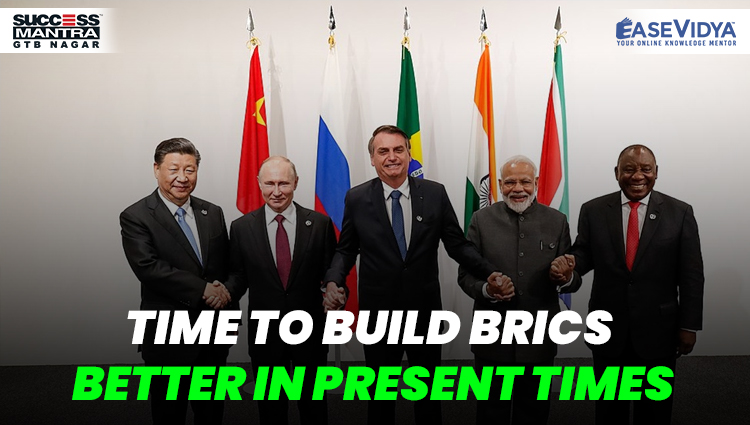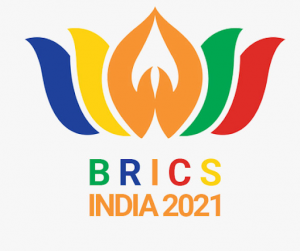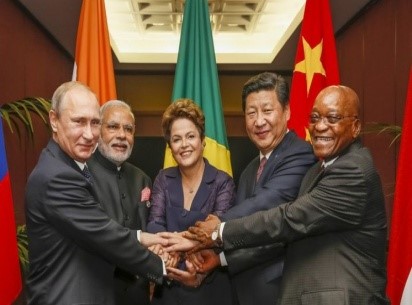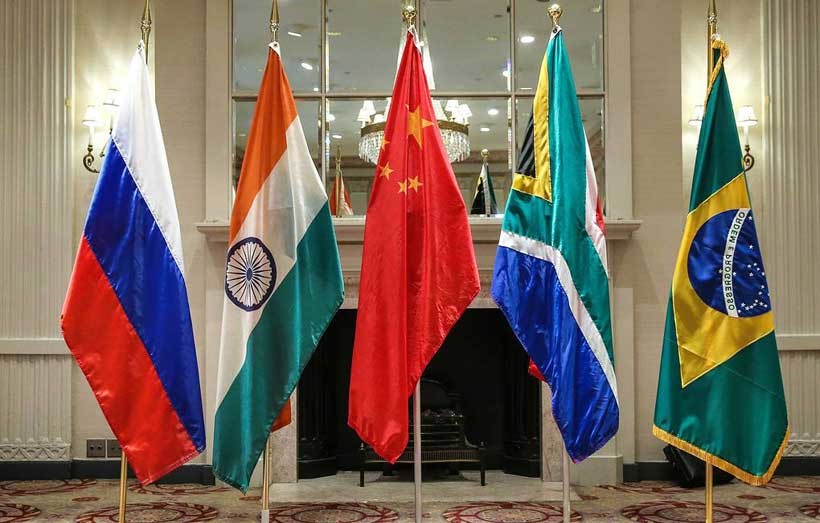
TIME TO BUILD BRICS BETTER IN PRESENT TIMES
TIME TO BUILD BRICS BETTER IN PRESENT TIMES
The 13th BRICS summit 2021 is set to be held in digital format under India’s chairmanship. This plurilateral grouping comprising Brazil, Russia, India, China and South Africa is chaired by turn. India held the chair in 2012 and 2016 too. The grouping succeeded up to a point but it now confronts multiple challenges.It is high time to identify the challenges and take some steps forwards.

SIGNIFICANCE OF BRICS
- Big Five Nations: Launched by a meeting of the Foreign Ministers of Brazil, Russia, India and China in 2006 and riding on the political synergy created by regular summits since 2009, BRIC turned itself into BRICS in 2010, with the entry of South Africa. The importance of BRICS is self-evident: it represents 42% of the world’s population, 30% of the land area, 24% of global GDP and 16% of international trade.
- Bridge Between North and South: The grouping has gone through a reasonably productive journey. It strove to serve as a bridge between the Global North and Global South.
- Common Global Perspective: The BRICs called for the reform of multilateral institutions in order that they reflect the structural changes in the world economy and the increasingly central role that emerging markets now play.
- Development Cooperation: It developed a common perspective on a wide range of global and regional issues; established the New Development Bank (NDB); created a financial stability net in the form of Contingency Reserve Arrangement; and is on the verge of setting up a Vaccine Research and Development Virtual Center.
CHALLENGES WITH THE BRICS ORGANIZATION
- Marred by Various Issues: Group has seen conflicts such as China's aggression in eastern Ladakh last year brought India-China relations to their lowest point in several decades. There is also the reality of the strained relations of China and Russia with the West, and of serious internal challenges preoccupying both Brazil and South Africa. On the other hand, China’s image at global level has also been tarnished due to the Covid-19. In this backdrop, it is questionable whether BRICS matter or not.
- Heterogeneity: It is claimed by critics that heterogeneity (variable/diverse nature of countries) of the BRICS nations with its diverse interests possess a threat to the viability of the grouping.
- China Centric: All the countries in the BRICS group trade with China more than each other, therefore it is blamed as a platform to promote China’s interest. Balancing trade deficit with China is a huge challenge for other partner nations.

- Global Model for Governance: Amidst, global slowdown, trade war and protectionism, the critical challenge for the BRICS consists in the development of a new global model of governance which should not be unipolar but inclusive and constructive. The goal should be to avoid a negative scenario of unfolding globalization and to start a complicated merging of the global growing economies without distorting or breaking the single financial and economic continuum of the world.
- Not Been Effective: The five-power combine has succeeded, albeit up to a point. However, China’s economic rise has created a serious imbalance within BRICS. Also the group has not done enough to assist the Global South to win their optimal support for their agenda.
PRIORITY OF BRICS AS ORGANIZATION
Achieving Multilateralism: The first is to pursue reform of multilateral institutions ranging from the United Nations, World Bank and the International Monetary Fund to the World Trade Organization and now even the World Health Organization. This is not a new goal. BRICS has had very little success so far, although strengthening multilateralism serves as a strong bond as well as a beacon. Reform needs global consensus which is hardly feasible in the current climate of strategic contestation between the U.S. and China and the devastation caused by Covid-19 to health, lives and livelihoods.

Resolve to Combat Terrorism: Terrorism is an international phenomenon affecting Europe, Africa, Asia and other parts of the world. Tragic developments concerning Afghanistan have helped to focus attention sharply on this overarching theme, stressing the need to bridge the gap between rhetoric and action. In this context, BRICS is attempting to pragmatically shape its counter-terrorism strategy by crafting the BRICS Counter Terrorism Action Plan containing specific measures to fight radicalisation, terrorist financing and misuse of the Internet by terrorist groups. This plan is expected to be a key deliverable at the forthcoming summit and may hopefully bring some change. Promoting Technological and Digital Solutions for the Sustainable Development Goals (SDGs). Digital tools have helped a world adversely hit by the pandemic, and India has been in the forefront of using new technological tools to improve governance.
Expanding People-to-people Cooperation: However, enhancing people-to-people cooperation will have to wait for international travel to revive. Interactions through digital means are not a full substitute of in person meetings.
OTHER POINTS TO REMEMBER
Cooperation Within the Group: BRICS need to shed the centrality from China and create a better internal balance, reinforced by the urgent need for diversification and strengthening of regional value chains, all exposed during the pandemic. Policymakers have been encouraging an increase in intra-BRICS cooperation in diverse areas like agriculture, disaster resilience, digital health, traditional medicine and customs cooperation. BRICS did well in its first decade to identify issues of common interests and to create platforms to address these issues. For BRICS to remain relevant over the next decades, each of its members must make a realistic assessment of the initiative's opportunities and inherent limitations.
Commitment to Multilateral World: BRICS nations need to recalibrate their approach and to recommit to their founding ethos. BRICS must reaffirm their commitment to a multi-polar world that allows for sovereign equality and democratic decision making. They must build on the success of the NDB and invest in additional BRICS institutions. It will be useful for BRICS to develop an institutional research wing, along the lines of the OECD, offering solutions which are better suited to the developing world. BRICS should consider a BRICS-led effort to meet their commitments under the Paris Agreement on climate change and the UN's sustainable development goals. This could include e.g. setting up a BRICS energy alliance and an energy policy institution. BRICS nations should strive for peaceful and politico-diplomatic settlement of crisis and conflict in various regions of the world.
CONCLUSION
Thus, the future of BRICS depends on the adjustment of the internal and external issues of India, China and Russia. Mutual communication between India, China and Russia is important for moving ahead.
TEST YOURSELF
Q.1 The 13th BRICS summit 2021 is set to be held in digital format under the chairmanship of which of the following BRICS nations?
- China
- Russian Federation
- South Africa
- India: ANSWER
Q.2 The plurilateral grouping of BRICS comprising Brazil, Russia, India, China and South Africa is chaired by turn. India holds the chairmanship two times in which of the following years?
- 2008 & 2012
- 2012 & 2016: ANSWER
- 2011 & 2016
- None of the following
Q.3 Consider the given statements & state which of the following statements is/are incorrect in the reference to the above mentioned passage?
- The acronym "BRICS" was initially formulated in 2001 by economist Jim O'Neill, of Goldman Sachs, in a report on growth prospects for the economies of Brazil, Russia, India and China
- Russia was the last country to join the BRICS as it was invited in December 2012, after which the group adopted the acronym BRICS.
- Only I follows
- Only II follows: ANSWER
- Both I & II follows
- None of the above
Q.4 The New Development Bank (NDB) which is formerly referred to as the BRICS Development Bank is headquartered in _________?
- Moscow, Russia
- Beijing, China
- Shanghai, China: ANSWER
- Johannesburg, South Africa
Q.5 Which of the following countries are recently approved as the new members of New Development Bank (NDB) also known as BRICS Bank?
- UAE, Uruguay & Bangladesh: ANSWER
- Saudi Arabia, UAE, & Bangladesh
- UAE, Uruguay & Uzbekistan
- Uzbekistan, Saudi Arabia & Qatar













0 Comment